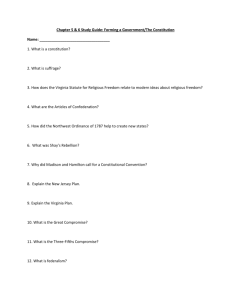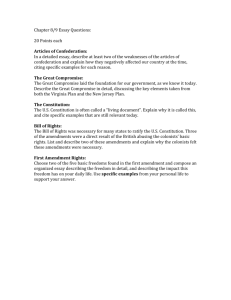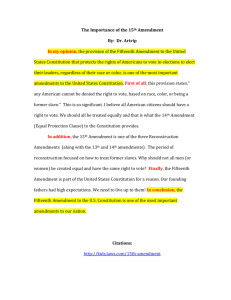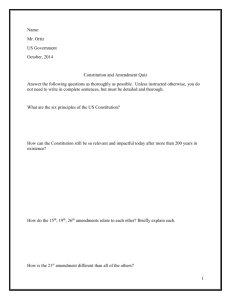Overview of the Constitution
advertisement
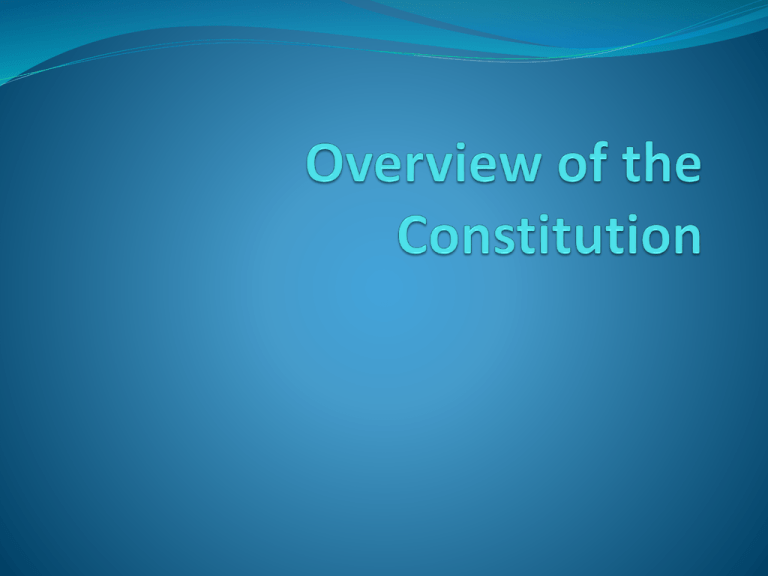
Warm-up for 1/22 and 1/23 Imagine that you have just declared independence from Great Britain, if you were in charge of helping to create our new government, what are 5 laws would you create? Write down your homework. Raise your hand when done. After the American Revolution, the Articles of the Confederation were enacted The Articles gave no power to the central government All the power resided in the states People were afraid of a strong central government In 1787, the Constitutional Convention was called in Philadelphia for the purpose of improving the Articles of the Confederation What came out was a new document A struggle began between the small and large states regarding representation The Virginia Plan proposed representation based on population The New Jersey Plan proposed equal representation from each state regardless of size The Great Compromise called for a bicameral (two house legislature), one based on population, one with equal representation With the Great Compromise, the ratification of the Constitution only had one more hurdle Many wanted to ensure the Federal Government would not become too powerful The Constitution was ratified in 1787 with the understanding it would be amended to include a list of citizens rights The Bill of Rights, the first ten amendments, were ratified in 1791 The US Constitution consists of seven articles and 27 amendments The original seven articles took effect in 1789 The first 10 amendments are called the Bill of Rights The Constitution consists of three parts: the Preamble, the Articles, and the Amendments The Preamble is the purpose The Articles establish the government The Amendments protect the rights of the citizens The Preamble The Preamble is the purpose for the document Form a more perfect Union Establish Justice Insure domestic tranquility Provide for common defense Promote general welfare Secure the Blessings of Liberty The Articles Article 1- Legislative Branch Congress shall make the laws Two parts, called “Houses” The House of Representatives The Senate Article 2- Executive Branch The President, Vice-President, Cabinet, and Departments Enforce the laws Article 3- The Judicial Branch The Supreme Court Rule on the laws Article 4- States powers States can make their own laws States must respect other states laws Article 5- Amendments Constitution can be changed Article 6- Federal Powers State laws cannot violate federal laws or the Constitution Article 7- Ratification Presented on September 17, 1787 12 out of the 13 states signed the Constitution The Amendments The first ten amendments are called the Bill of Rights The 13, 14, and 15th amendments ended slavery, established citizenship and gave Blacks the right to vote (1870) The 18th amendment was the only amendment repealed, prohibition against the sale of alcohol (1919) The 19th amendment gave women the right to vote (1919) The 22nd amendment limited the President to two terms (1951) The 26th amendment gave 18 year olds the right to vote (1971) The 27th amendment Congress shall not have a raise until after the next election of the House of Representatives (1992) The Bill of Rights Revolutionary in their nature Two groups grew out of the ratification process for the US Constitution Federalists did not believe in the need for the Bill of Rights Wanted strong Federal Government Members include: Alexander Hamilton and James Madison Anti-Federalist Distrusted a strong Federal Government Proposed the Bill of Rights Members include: Thomas Jefferson Guaranteed the rights of the citizens and could not be infringed by the Federal Government Freedoms include Speech Religion Bear arms Speedy trial States rights
